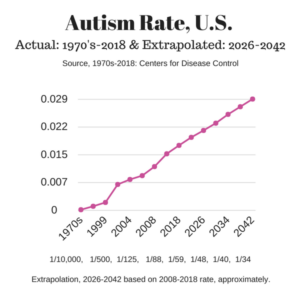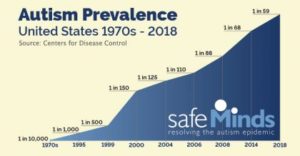(originally posted on March 18, 2013, most recent update 4/9/17)
Research suggests that pyroluria is a condition caused by a genetic difference that prevents the normal breakdown of pyrroles which are side products of hemoglobin breakdown. [5 , 8] The excess pyrroles are not toxic but when they aren’t broken down to smaller chemicals they instead combine with vitamin B6 and zinc and form a compound that is excreted by the kidneys. In normal metabolism zinc and B6 molecules would be recovered for reuse instead of being excreted. The daily nutrient loss can lead to a chronic deficiency of vitamin B6 and zinc and a variety of symptoms.
 Symptoms of Pyroluria:
Symptoms of Pyroluria:
Physical symptoms might include white spots on the fingernails from zinc deficiency. The spots can occur where a bruise to the fingernail occurred but they are more likely to form when zinc deficiency is present. Zinc is important for both wound healing and cell growth so skin infections may also be more common. Stunted growth and teeth that are crooked from overcrowding may result when zinc deficiency is a chronic problem throughout childhood.
Poor dream recall is a symptom of B6 deficiency. Digestion problems and skin symptoms may occur. Dry peeling lips with poorly healing cracks at the corners of the mouth may be a problem with B6 deficiency.
Migraines, seizures and joint pain may be symptoms of pyroluria. Insomnia, exhaustion and sensitivity to light and sound may be problems. Anxiety can become severe over time and the person may isolate themselves to reduce stress. Depression, mood swings and temper outbursts are possible symptoms. [3, see link for more physical signs and symptoms.]
I learned of pyroluria as a possible cause of B6 and zinc deficiency in a book by Julia Ross, MA, called The Mood Cure, The Four Step Program to Take Charge of Your Emotions – Today. It included a self test and information from a book by Joan Mathews Larson, PhD, called Depression Free Naturally. Excerpts are available on her website which include more detail about pyroluria as a treatable cause of anxiety and depression: [7] Her work has helped patients at the Health Recovery Center for years. The center uses therapies designed to restore nutrient balance and correct deficiencies that may be underlying causes of anxiety, depression or addictions. [healthrecovery.com]
Zinc and B6 are needed for production of neurotransmitters that help prevent anxiety and depression. Mental health problems caused by nutrient deficiencies would not be helped much by typically prescribed antidepressants or anti-anxiety drugs. [1]
Ten percent of people may suffer from pyroluria but the condition is not yet widely recognized in the medical field. A research study found the condition to be more prevalent in people with mental health diagnoses and in groups of violent criminals. The pyrrole chemical was present in 71% of adults charged with sudden onset criminal behavior and in 33% of youth charged for a violent crime. Evidence of pyroluria was also more commonly found in patients with OCD, Multiple Sclerosis, Parkinson’s disease or Lyme Disease. It was found in 40% or more of people with autism, ADHD, manic depression (bipolar disorder), schizophrenia, Down’s Syndrome, epilepsy, or porphyria. [3, 5 ]
/Speculation/ This could explain why some studies have found B6 supplements helpful for autism but others weren’t able to replicate the results. If 40-50% of the autistic patients in a study had undiagnosed pyroluria then those participants might find high dose B6 supplements very helpful while the rest of the study group might not notice any change.
Pyroluria may also be associated with hypothyroidism and iodine deficiency according to lecture by Dr. Erica Peirson. And a lack of stomach acid may be involved and which would increase risk of nutrient deficiencies. If that is a chronic condition then having salsa or a dill pickle or something else acidic with larger meals can help improve digestion and absorption of B vitamins and other nutrients, especially as we get older in years. Watch this video, Dr Erica Peirson – Pyroluria: Links to Down syndrome and autism, for more information: [10] .
The good news is that, once identified, pyroluria is very treatable with use of well absorbed forms of vitamin B6 and zinc. The bad news — the supplements have to be taken everyday because the amounts needed are more than is really possible to be found in foods. The supplements are replacing the excessive nutrient loss caused by the daily excretion of the nutrient pyrrole compounds. Deficiency symptoms may start to return after only 48 hours without the high dose zinc and B6 supplements. [3]
A few other nutrient supplements may also be needed to restore nutrient balance. Magnesium may be helpful and niacin (B3), pantothenic acid (B5) and manganese may also be deficient. [1] The essential omega 6 fatty acid, arachidonic acid, may also become deficient. [2] The nutrients, zinc and vitamin B6, are essential for enzymes active throughout the body. Deficiency of B6 may lead to digestive problems and impaired absorption of B12 and other nutrients. Zinc deficiency can also lead to excessive levels of copper which can be neurotoxic and may require chelation therapy. [3] Avoiding foods rich in copper and red and yellow food dyes may be helpful. [2]
Evening primrose oil is recommended as an additional supplement by a medical doctor in the following post. Evening primrose oil would be a good source of essential omega 6 fatty acids. More detail is included in the article about the mental health and other physical symptoms common for patients with pyroluria to experience. It also states in the article that treatment with the supplements can quickly end the negative symptoms for patients when the condition is first diagnosed and treated. [8]
I have found personally that continuing the supplements daily is an ongoing necessity. Earliest symptoms of the B6 and zinc deficiency may be experienced after only missing a few days of the supplements. For me increased anxiety and headaches may occur after only a couple days of forgetting the supplements.
Before I had discovered the problem zinc deficiency was severe enough for me to have many white spots on my fingernails and for me it also seemed to be the cause of anorexia – extreme lack of appetite. Which is a symptom that was not mentioned in the article [8] that included a long list of symptoms. See excerpt:
Here is Dr. Walsh’s list of some of the symptoms correlated with pyroluria: Poor stress control, sensitivity to bright lights and loud noises, morning nausea, tendency to delay or skip breakfast, very dry skin, pale skin, inability to tan, high irritability and temper, history of underachievement, little or no dream recall, auto immune disorders, white spots on the finger nails, poor growth, coarse eyebrow hair, stretch marks on the skin, severe anxiety and/or depression, fearfulness, obsessions with negative thoughts, delayed puberty, dark or mauve colored urine, affinity for spicy and salty foods, abnormal fat distribution, delicate facial features, extreme mood swings, history of dyslexia, severe inner tension, frequent infections, premature graying of hair, poor muscle development, spleen area pain, joint pain, poor wound healing, psoriasis, tendency to stay up very late, abnormal or absent menstrual periods. [8]
Zinc deficiency has been associated with anorexia nervosa. [9] For me at the time, swallowing just one or two bites of food at the time would seem like a lot of work. The food felt like dry sawdust when I would try to swallow and my mood when being encouraged to eat would tend towards feelings of “how can you ask such a difficult task of me,” (eating shouldn’t promote anxiety or feel like sawdust). Once I had been on the high dose supplements for a little while my appetite normalized and I don’t get many white spots on my fingernails (an opaque white spot instead of the pinkish color of the skin under the nailbed; white spots may appear in anyone’s fingernail after a bump or some sort of injury damaged it).
Caution: Taking high dose zinc supplements can be dangerous to copper balance in people who do not have pyroluria.
Gluten intolerance and excessive use of coffee or other diuretics may increase the severity of the condition. [3] Infections or other problems that cause increased destruction of red blood cells could also exacerbate the condition. The pyrroles can be a produced during hemoglobin synthesis and also during break down of red blood cells. [6]
If white spots on fingernails seems like a normal part of life then consider reading more about pyroluria. [7] Not all physicians are familiar with the condition and lab samples need to be treated carefully or the pyrrole compound will deteriorate. One lab protects samples from oxidizing by adding ascorbic acid (vitamin C) to the collection tube and the sample is then kept out of light and is frozen until testing. [4]
More information about vitamin B6 and food sources is available here: Vitamin B6
Disclaimer: Opinions are my own and the information is provided for educational purposes within the guidelines of fair use. While I am a Registered Dietitian this information is not intended to provide individual health guidance. Please see a health professional for individual health care purposes.
- By Julia Ross, MA, “The Mood Cure, The Four Step Program to Take Charge of Your Emotions – Today,” (Penguin Books, 2004 ed., New York) p314-315 *This book also addresses nutrients that can help during addiction recovery in addition to other mood disorders.
- J. Kaslow, MD, “Pyroluria,” DrKaslow.com: [drkaslow.com] This article suggests that avoiding red and yellow food coloring may be helpful.
- “Pyroluria, A Hidden Disorder,” Naturalinsight.hubpages.com: [naturalinsight.hubpages.com]
- “Do I Have Pyroluria,” A self test about the condition is available on this laboratory website under the Reference Tab: [kryptopyrrole.com/]
- McGinnis WR, et. al., “Discerning the Mauve Factor, Part 1,” Altern Ther Health Med. 2008 Mar-Apr;14(2):40-50. [ncbi.nlm.nih.gov] *The abstract mentions that use of B6 and zinc or the use of antibiotics helped reduce urinary excretion of hydroxyhemopyrrolin-2-one (HPL). The chemical was originally nicknamed the Mauve Factor, due to its purplish color. Prednisone has been known to increase urinary loss of HPL and it is theorized that increased stress would also cause increased excretion of HPL possibly due to changes in intestinal permeability that affect urinary concentrations.
- A patient forum, braintalkcommunities.org, has a post by member, Halsgluten, which suggests that SIBO, small intestine biofilm/bacterial overgrowth, may add to pyrrole production by causing an increase in red blood cell breakdown. The pyrrole compound, HPL, can be formed during synthesis of hemoglobin or during destruction of red blood cells. *The observation that antibiotics helped in reference #5 could be due to their helping fight an underlying intestinal infection or other chronic infection that is causing destruction of red blood cells.
- Joan Mathews Larson, PhD, “Soothing the Anxious Brain,” includes excerpts from her book, “Depression Free Naturally,” [joanmathewslarson.com]
- Pyroluria, Mental Health and the Immune System, JudyTsafirMD.com,
http://www.judytsafrirmd.com/pyroluria-mental-health-and-the-immune-system/
- Humphries, L., et al., Zinc deficiency and eating disorders. J Clin Psychiatry. 1989 Dec;50(12):456-9. https://www.ncbi.nlm.nih.gov/pubmed/2600063
- Video: Dr Erica Peirson – Pyroluria: Links to Down syndrome and autism, https://www.youtube.com/watch?v=nOFU7q9EIyM



 Symptoms of Pyroluria:
Symptoms of Pyroluria: